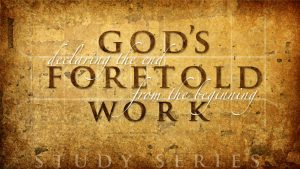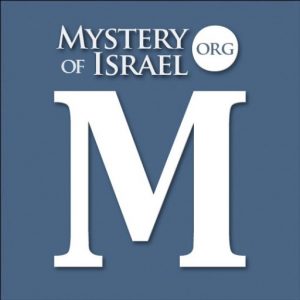From the 2022 God’s Foretold Work: The Everlasting Gospel Convocation. The audio has been cleaned up compared to the LIVE version.
Thoughts on the Mystery of Heavenly Hindrance
Only weeks apart, I received the same question from two dear friends. It is a question many have asked, and it is one that has the potential to cast great light on much else. Here’s how one friend put the question:
“It is clear the nameless one (described in Dan 10:4-11:1) is the Lord Jesus given clear unity with Revelation 1. How do you understand His being delayed and receiving help from Michael to release the word?”
Even among those commentators who see verses 5-9 as depicting a pre-incarnate appearing of Christ, most will argue that beginning at verse 10, another figure has come into view. The proposed change from Christ to an angel is assumed only because it is thought to be inconceivable that the pre-incarnate Son could need angelic assistance to push past the resistance of the demon Prince of Persia to complete his errand to Daniel (Dan 10:13).
[And what a strategic errand it was! It was to be an exceptionally long, uninterrupted (two chapters), unparalleled, narrative style prophecy that would lay out in astonishing detail “what shall befall your (Daniel’s) people in the latter days.” No wonder the demonic realm was so invested to impede the messenger’s mission. It is important to note what this mighty, history-determining breakthrough of divine revelation cost Daniel, as well as the place that sovereign providence had brought him in preparation for it.]
Yet, does the view that an angel has stepped in in place of the glorious Christ really solve our problem? It still leaves the question, why would the holy angels, sent by God, ever be successfully detained? Wouldn’t it be expected that the only assistance they would need to fulfill their mission would be amply supplied by God Himself? What then is this mystery of demonic resistance? What is its purpose in the great scheme of God’s eternal purpose? Why the struggle? …
[Click/Tap “Jump to full post” below for more]
Apocalyptic Evangelism Course (2002)
We have recently recovered some of the printed material from the Ben Israel Apocalyptic Evangelism Course announced in the Fall 2001 Newsletter. Please note the downloadable PDF’s next to each title. A couple of the article’s had already been published on the mysteryofisrael.org site.
04-14-11 Update: We have now made all articles viewable online for easier access to Scripture references.
08-23-22 Update: Originally posted on mysteryofisrael.org in 2011. More recently we have fixed all of the links and thought to bump it to the top again. We have also tagged a number of articles with the “Apocalyptic Evangelism” category.
Module 1:
- What is Apocalyptic Evangelism? [PDF]
- What Difference Does It Make How Christians View Prophecy? [PDF]
- The National Hope in Context [PDF] (part of a larger piece called
“The Historic Impasse Between Church and Synagogue”) - The Hebraic View of Prophecy [PDF]
- The Significance of Jerusalem in Prophecy [PDF]
Module 2:
For further information on the ongoing development of the Apocalytic Evangelism Course click/tap here.
The Only True Doer
We say no sin is too great and no sinner is too far (excepting, of course, those who have put themselves “past feeling”)! God is very near to those who feel their destitution (Ps 102:17), especially in those moments of utter weakness that attends the end of mortal life. Never was there a greater, more sovereign revelation than that which broke upon the thief on the cross at the point of greatest weakness and self-despair!
This profound spiritual principle – manifest throughout the scriptures – is most clearly seen at Israel’s appointed time of national deliverance. The veil covering the Jewish heart will be removed “at the set time” …“in one day”…“at once” when the penitent survivors of Israel will “look upon Him whom they pierced” (Ps 102:13; Isa 25:7; 66:8; Eze 39:22; Zech 3:9; 12:10; Mt 23:39; Ro 11:26; Rev 1:7; 10:7). But critically, this transformative revelation is given “when He (Yahweh) sees that their power is gone” (Deut 32:36 with Dan 12:7).
The power of His endless life is revealed at the end of the pride of self-reliance (the strength of the veil) which hides the transformative liberating revelation of the glory of God in the face of Jesus Christ (2Cor 3:14-18; 4:6). This withering process of crisis is critical for shattering the pride of self-reliance, not only in the unbelieving, but as Paul explains, God wisely uses it even in the lives of the godly (Acts 14:22; 2Cor 1:8-10; 12:7).
At the inception of faith, the free gift of an everlasting righteousness is immediately imputed. But saving faith comes when the Spirit has used the unapproachable holiness of the law to drive the sinner off of any hope in themselves (Ex 19:16m 21-24; 20:18-19; Ro 7:9; Gal 3:10, 19, 21). This is why the Law must come first (Jn 1:17). When the real implications of the law’s holy requirement is brought home to the heart, the gospel of a righteousness that is utterly transcends our hearts becomes exceedingly good news…
[Click/Tap “Jump to full post” below for more]
Convocation 2022
Greetings brothers and sisters!
It’s always a bit of a challenge to come up with a fitting title for the annual conference, one with a prophetic end-time emphasis and one with a broad enough scope for a multi-speaker event. This year, when the online participants of God’s Foretold Work met in a Zoom meeting to discuss this, the Lord directed them toward themes of recent Saturday evening online meetings by which folks were particularly blessed and encouraged. Consensus came when they heard:
“God’s Foretold Work: The Everlasting Gospel”
Revelation 14:6 “And I saw another angel fly in the midst of heaven, having the everlasting gospel to preach unto them that dwell on the earth, and to every nation, and kindred, and tongue, and people…”
May the Lord bless both the words brought forth and every hearing heart. Let’s pray that we will leave this conference with health, hope, encouragement and His gracious preparation of our hearts and minds for the days to come!
We have been LIVE Streaming from THIS YouTube Channel.
GOD’S FORETOLD WORK: The Everlasting Gospel
Our invited speakers were: Travis Bennett, Reggie Kelly, Tom Quinlan, Adam Smith, Willie Wallace, and Brett Tompkins.
Brock Hollett and Fred London shared with us via video.
Day 1
Tom Quinlan – God’s Foretold Work – Declaring the End from the Beginning
VIDEO
Day 2
Fred London – Back to the Future
VIDEO
Reggie Kelly – A Daniel’s Eye View of the Everlasting Righteousness of the Everlasting Covenant:
Unpacking Dan 9:24 – Video
Brett Tompkins – The Everlasting Gospel: To the Praise of the Glory of His Grace
VIDEO
Day 3
Travis Bennett – Seeing the Unseen
VIDEO
Brock Hollett – The Meaning of Christ’s “This Generation”
VIDEO
Brett Tompkins – The End of All Things is at Hand: To the Praise of the Glory of His Grace
VIDEO
Day 4
Willie Wallace – Waiting Time is Testing Time
VIDEO
Reggie Kelly – The Climax of the Covenant
VIDEO
Travis Bennett – The Unseen Work of Affliction
VIDEO
Day 5
Tom Quinlan – He Has Redeemed Us from the Curse of the Law
VIDEO
Blessings!
Adam & Cheryl
We would appreciate it if you could direct emails to bemidji.summer.conference@gmail.com (Keeps everything together in one place. Thanks!)
Ye MUST Be Born Again
One thing I would say without looking at the whole superstructure, which time simply does not permit, is the really foreign thought that God is fishing for DNA in order to mediate His salvation. That someone named Kelly, for example, is saved, not strictly because of the drawing power of the Holy Spirit, and response of faith to God’s great, “whosoever will” extended to all nations without discrimination, but because my physical lineage has some surviving genetic element that can be traced back (or that can only be assumed on the basis of what I believe) to one of the supposedly lost ten tribes of Israel (see David Baron’s excellent little pamphlet by that title). That just doesn’t square with the mystery that Christ is revealed ‘in’ gentiles, without discrimination, and that gentiles of “every” tribe, tongue, and nation are equally made Abraham’s seed through faith alone. Such a thesis is suspicious from the start!
Yes, I believe and affirm that God preserves an ethnic distinction from among the natural branches precisely in order to demonstrate and set on public display His covenant word to Israel for the vindication of His sovereignty in divine election, and for the instruction of the nations and the fallen order of principalities and powers through what He has purposed to show through them. A preserved remnant from among the natural branches will indeed be born in a day (Isa 66:8; Zech 3:9) and gathered from all nations, never to be invaded again. That is sure and certain! Until then, they are made sufficiently distinguishable as a distinct ethnic race precisely in order to show in them the discipline of the covenant and to test the hearts of all nations concerning this blinded people who, though momentarily enemies of the gospel, are NONETHELESS BELOVED, and are to be so regarded, to the chagrin of those nations who have laid malicious, unfeeling hands on God’s afflicted in their pitiable ghetto condition, a presumption that will be much required in that day.
(… More …)
Crucial Distinctions Regarding the “Church”
I’ve always maintained that “this one and that one were born in her” (the heavenly Zion; Ps 87:3-7; Gal 4:16; Heb 12:22-23; Rev 12:1-2, 17; 19:7; 21:2, 9-10 with Jn 3:29). The Psalmist can’t conceive of any of the saved of the nations, regardless of geographical location, as being born (born again) outside of Zion. But which Zion? There is an heavenly and an earthly, but until the twain do meet in that coming day, they remain distinct, though never separate.
The gentiles have always been debtors to their Hebrew roots since God first separated Abraham and declared His electing love of Zion. All redemptive goals take us to the heavenly city of the saved of all nations, but on the way towards that ultimate, post-millennial goal, the line of sovereign election must pass through the Jerusalem which is now in bondage with her children. The covenant must be openly vindicated on this present earth by its ultimate realization in the salvation of “all Israel”, preserved in faithful obedience by the new heart of the New Covenant for a thousand years. Here, we take a comparatively rare view of Paul’s meaning, “and so all Israel shall be saved” (Ro 11:26).
We are intensely agreed that Paul is NOT speaking of the full ingathering of all of God’s elect, an attractive suggestion by supercessionists, if looked at only superficially. But rather, Paul is reiterating what all the prophets understood as the climax and final resolution of the covenant, as the prophets envisioned an all saved Jewish, nation empowered by the outpoured Holy Spirit, and controlled by a new heart and new spirit to abide in covenant faithfulness for a thousand years of open testimony to the nations.
(… Click below for more …)
The Signs Before THE Sign
In order for our view of the two days to be vindicated, we would have to see the signs that precede the principal sign that Jesus gives, all within a very short period of time. By understanding this particular, centermost event, all other principal events of the end are aligned and set in order.
I am speaking of the “abomination of desolation”. This is the event that Jesus directs His disciples to “read and understand” (Mt 24:15). Jesus well knew that by obedience to His solemn command to identify and understand this event, it would become possible for His sheep to recognize a number of other preliminary signs that must precede and lead up to the abomination of desolation (Mt 24:15 with Dan 8:11-14; 9:27; 11:31: 12:11).
It is these well defined events, one that is particularly unmistakable, that will alert, awaken, and mobilize the saints for their finest hour of witness and triumph over Satan and the man of lawlessness. There is a divine strategy that God has invested in making the approximate time of His coming unmistakably clear to His saints when these key, preliminary signs will be in clear, unmistakable fulfillment.
But I don’t want to begin my answer by simply laying out the order of events leading to Christ’s return. We have done that often elsewhere. Instead, I want to point out the interpretive key that is essential to support and defend our view of the end from all other competing interpretations, both now and across the annals of church history.
It is crucial that this be in the hands and understanding of God’s people for the sake of the many that will be called upon to give an answer, as we expect that the manifest fulfillment of the prophecies on the open stage of history will prove the greatest evangelistic tool since the days of the early church (Dan 11:32-33; 12:3; Rev 7:9, 13-14).
This critical key of interpretation is found in the most unexpected place. By God’s design, the event that so clearly and indisputably holds all else in proper alignment is also the most misunderstood and commonly dismissed. I speak of the indispensable sign of the sacrifice.
(… More …)











